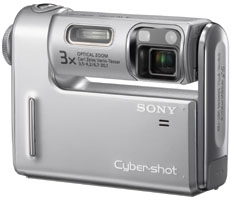 |
|
|||||||
|
Reviews
SONY Cyber-shot DSC-F88 Well, I was wrong. The F88 and I didnât connect. As much as I adored the T1, the F88 turned out one of those cameras that I canât take into my hands without finding fault with it. Perhaps my expectations were too high, but itâs more likely that I simply donât like some of the design choices Sony made. Much of the trade press loves the F88, and so for once I will present the counterpoint and all the reasons why I felt let down by the F88. Let me qualify that right here by saying that the F88 is not a bad camera by any means. In fact, it is a very high quality camera with many good sides, and it may be just the ticket for many buyers. However, I am not one of them. First, what is the Cyber-shot F88? It is a ultra-compact 5.1 megapixel digital camera that measures about four by two inches and is about an inch thick. The design feature that sets it apart is a rotating lens assembly that lets you take pictures from above or below an object. That can come in very handy when you want to shoot something above the heads of a crowd, or when you want to ăshoot from the hipä so as to not attract a lot of attention. An additional benefit of a rotating lens assembly is that you can take those ever popular self portraits. So far so good. I really like the concept. Sony actually used the same innovative zoom mechanism it pioneered in the T1. A full 3X optical zoom fits into the lens assembly without the lens motoring out. Unlike my old Nikon Coolpixes where the whole left side of the camera rotated, with the F88 it is the upper part of the camera that rotates. Rotating also turns the camera on and off. Here we encounter Big Flaw #1. The camera turns off when you twist the lens assembly down about 30 degrees. So you might be standing there with a once in a lifetime chance at a certain overhead shot and.... the F88 turns itself off. No click, no stop, no warning. It just goes off. Very bad idea, and for me a total deal breaker. Second, even though the F88 is a bit larger than the T1, the way the rotating lens design is implemented leaves much less space for the LCD. I loved the T1âs sensational 2.5-inch outdoor viewable display and was dismayed to find a much smaller 1.8-inch LCD in the F88. Thatâs a world of a difference, especially since this seems a standard transmissive display whereas the T1 uses what Sony calls a ăhybridä LCD that is completely sunlight readable. To make matters worse, the LCD has an extremely narrow vertical viewing angle, exactly what you donât want in a camera youâre going to hold above or below you. There is a real-image optical viewfinder, but it is devoid of any information at all, and also lacks a diopter adjustment for folks who use reading glasses or need other help in the visual department. Third, whereas the T1 felt like an expensive high precision instrument in every respect, the F88 doesnât exude nearly the same elegance and quality. The body has an unfortunate mix of four different surface treatments (gray plastic, chrome and two levels of silvery powder finish) and though it is made in Japan it feels almost a little cheap. Controls, likewise, seem much less well thought out as they do on the T1. The zoom rocker sits too low and your fingers are constantly fooled by an array of Braille-style bumps right above the rocker and in the spot where you expect the zoom to be. The mode dial has a darkish finish that makes it difficult to read the icons and writing (three different sizes!) on it, and itâs not clear which function is selected. The situation is somewhat better with the rest of the manual controls which consist of a few push buttons and the by now almost standard five-way control disc. Unfortunately, things go bad again with onscreen menus where Sony liberally mixes icons and writing that are hard to see indoors and become hopelessly illegible outdoors.
All of this is too bad because the F88 has a whole bunch of good technology inside. Its 10 elements-13 groups Carl Zeiss Vario-Tessar 38-114mm equivalent zoom lens is not only a marvel in miniaturization and design, but also capable of above average picture quality. Like the T1, you can use either the standard 2X ăPrecisionä digital zoom or a 4X ăSmart Zoomä that zooms into an area rather than simply enlarging part of the display. An AF illuminator helps in getting sharp pictures in poor lighting conditions (though the small flash itself is fairly weak), and weâve always loved Sonyâs patented Info-Lithium battery technology that tells you how much longer you can shoot. The F88 also offers a very nice combination of point & shoot ease of use and a good degree of manual control for more advanced users. There are ten scene modes (represented by tiny icons), a movie mode with sound that records in 640 x 480 format until the Memory Stick or Memory Stick Pro is full, the ability to print directly to a PictBridge enable printer, a reasonably fast burst mode, and other goodies, most of which youâd expect in a $400 camera from Sony. I regret
feeling so ambivalent about a camera with such good pedigree and
such good individual components, but I really think Sony didnât
think this one through. As a result, the DSC-F88 is considerably
less than the sum of its parts, and the more expensive DSC-T1 is
a much better buy.
|
|||||||
|
|
|||||||
|
©
2004 D.C. Publications, Inc. All Rights Reserved. |
|||||||


 There
are things in life that you just know youâre going to like even
if you havenât seen them yet. A new book from your favorite author
might fall into that category, your loverâs new lingerie she teasingly
told you about on the phone, or perhaps that bottle of 1995 Opus
One Cabernet Sauvignon youâve been saving for a special occasion.
Me, I just knew that I was going to love the Sony Cyber-shot DSC-F88
that combines much of the technology and features of the incredible
Cyber-shot T1 with the rotating lens design that was my favorite
in many of Nikonâs early Coolpix cameras.
There
are things in life that you just know youâre going to like even
if you havenât seen them yet. A new book from your favorite author
might fall into that category, your loverâs new lingerie she teasingly
told you about on the phone, or perhaps that bottle of 1995 Opus
One Cabernet Sauvignon youâve been saving for a special occasion.
Me, I just knew that I was going to love the Sony Cyber-shot DSC-F88
that combines much of the technology and features of the incredible
Cyber-shot T1 with the rotating lens design that was my favorite
in many of Nikonâs early Coolpix cameras.